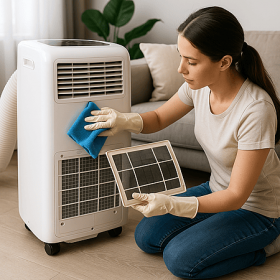Regular cleaning keeps your portable AC running efficiently and extends its life. When dust builds up, floor AC units work harder, cool poorly, and blow allergens around your home.
What You’ll Need:
- Vacuum with brush attachment
- Microfiber cloths
- Dish soap
- White vinegar
- Spray bottle
- Coil cleaner (for deep cleaning)
- Soft brush
- Fin comb.
Start by unplugging it, then tackle filters, exterior surfaces, coils, and the water system to clean it.
Portable Air Conditioner Cleaning Guide: Step by Step
Step 1: Power Off and Unplug
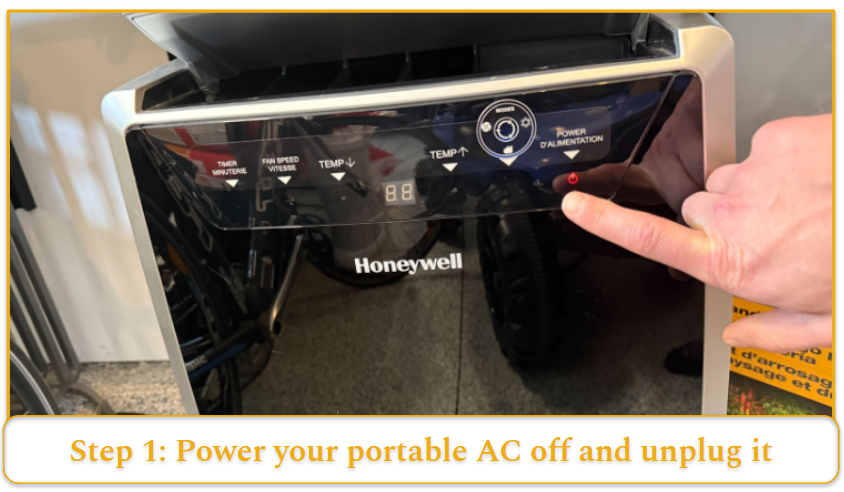
Always unplug before cleaning. I’ve seen shocked DIYers who thought “off” was safe enough. Give it 30 minutes to discharge any stored electricity before opening any panels.
Step 2: Empty the Water Reservoir
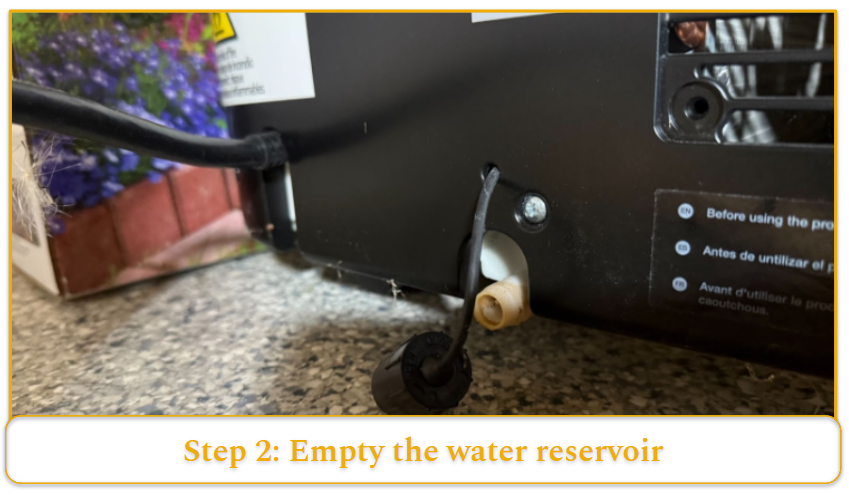
- Pull out that collection tank or open the plug to drain it (check your manual if you can’t find it).
- Dump the water.
- Wash with warm soapy water.
- Let it dry completely – trapped moisture grows mold like nobody’s business.
Step 3: Clean the Air Filters
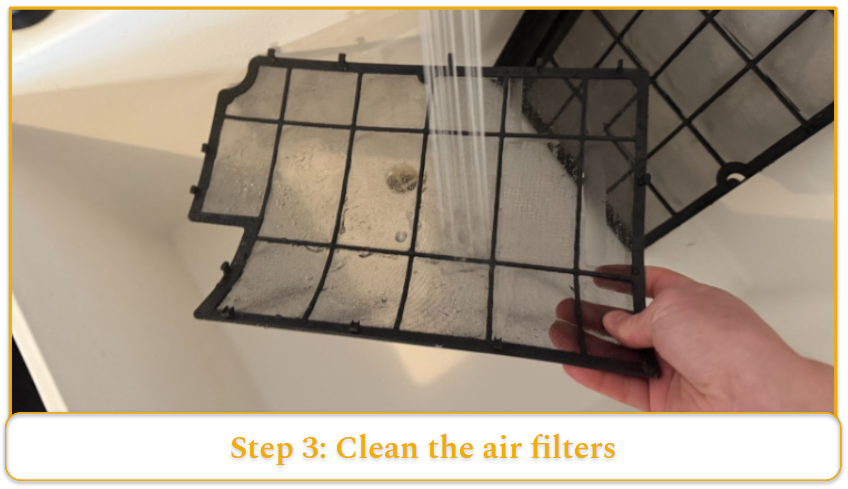
Pop out the filters from behind that plastic grille.
- Vacuum off the loose stuff with a brush attachment.
- Washable filters? Rinse under lukewarm water on the inside of the filter until the runoff looks clear.
- Air dry completely – wet filters grow mold and can damage your unit. Disposable ones just need replacing when they look dirty.
Step 4: Clean the Exterior
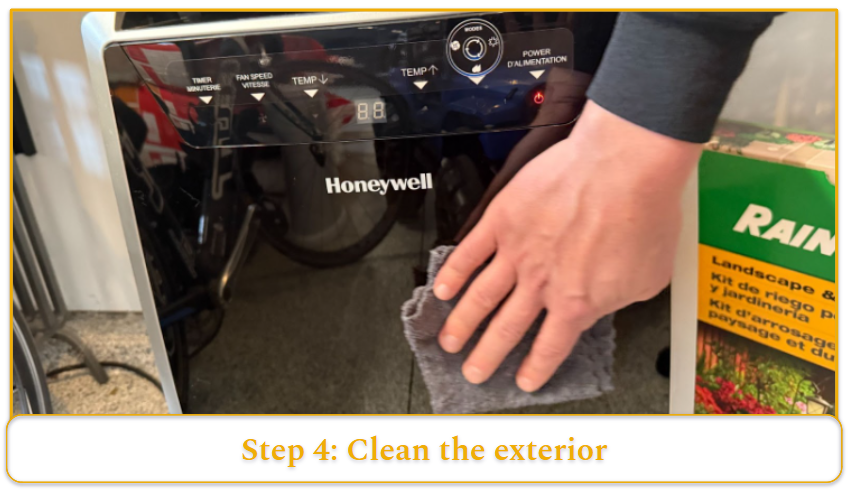
- Wipe everything down with a slightly damp microfiber cloth.
- Stubborn grime needs mild dish soap.
- The air intake vents collect dust bunnies like they’re going extinct – don’t skip those.
- Keep moisture away from controls and electrical parts.
Step 5: Clean the Coils and Fins
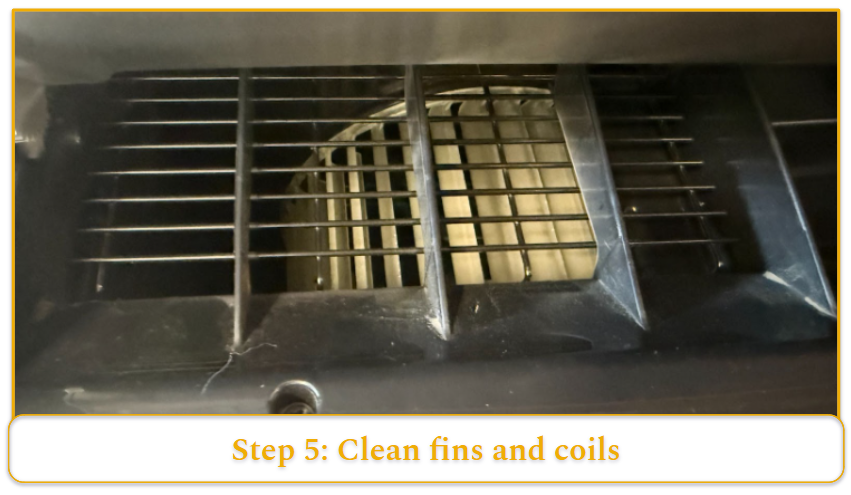
- Open panels according to your manual and vacuum visible dust with the brush attachment on low.
- If you have a heavy buildup that won’t come off, use a coil cleaner spray made for ACs. Follow the can directions – usually spray, wait, and let it drip-clean itself. I’ve seen people destroy fins by scrubbing – don’t do that.
Step 6: Clean the Exhaust Hose
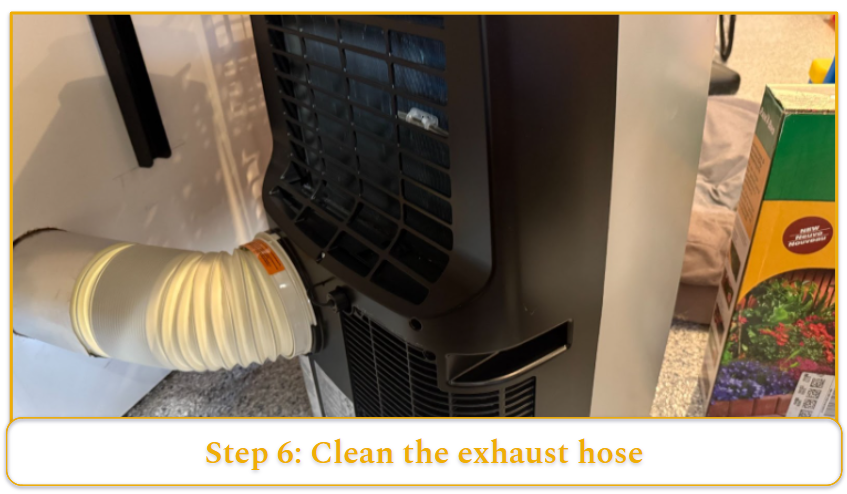
That flexible hose can collect an impressive amount of dust and mold.
- Disconnect it.
- Use a dryer vent brush to clean the inside.
- Wipe the outside with a damp cloth.
- Dry thoroughly before reconnecting.
Cleaning the Condensate Pump and Drain Line
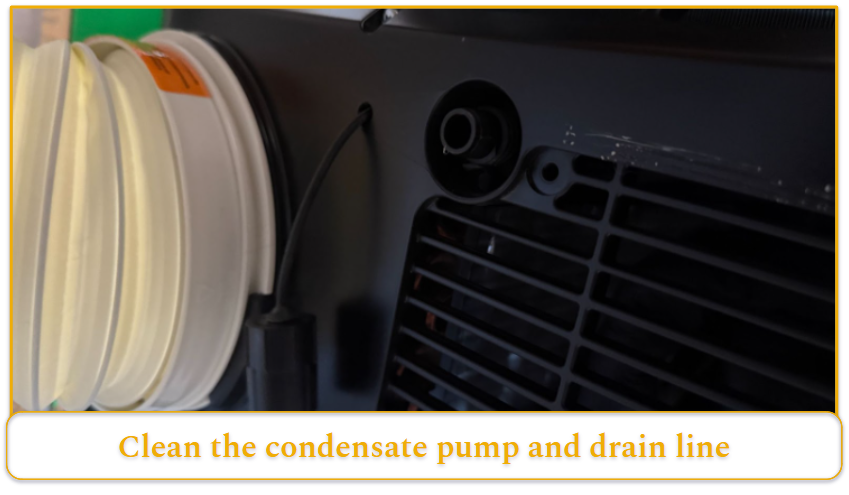 If your unit drains continuously or has a pump, you need to clean the line.
If your unit drains continuously or has a pump, you need to clean the line.
- Mix vinegar and water 50/50.
- Pour it through.
- Wait half an hour, then flush with clean water.
Last month I pulled slime from my condensate drain line that looked like it might start walking on its own.
Deep Cleaning Evaporator Coils
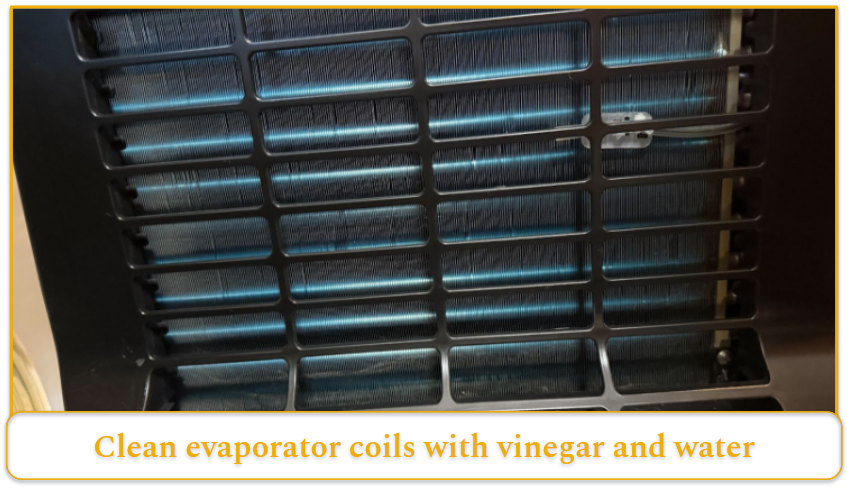
Nasty evaporator coils?
- Mix vinegar and water in a spray bottle.
- Mist lightly (don’t soak!).
- Wait 10 minutes and then wipe gently with a soft brush.
- Mist with clean water to rinse.
- Dry completely.
Cleaning the Vents and Louvers
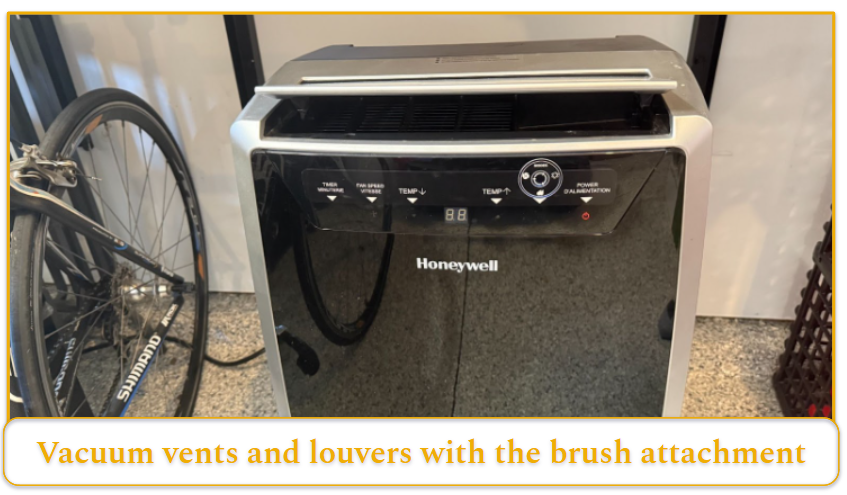
- Vacuum vents and louvers with the brush attachment.
- Wipe fixed louvers with a damp cloth.
- For adjustable ones, clean each slat carefully – they bend easily and replacements aren’t always available.
How to Clean a Very Dirty Portable AC Unit
Got a neglected unit?
- Take photos before disassembly – you’ll thank me later.
- Open all panels per manual instructions and vacuum everything.
- For coils with years of buildup, commercial coil cleaner is your only hope. Apply according to instructions – usually, it foams up and carries crud away as it drips. I suggest putting the AC unit over a tarp or a tray to collect all the runoff.
- Use compressed air for blower wheels and fans (outside or in a garage – it can create a lot of dust).
- Check water areas for slime and disinfect with vinegar solution.
Give everything a full day to dry before reassembly. I once rushed this step and had to replace a circuit board that shorted from lingering moisture.
Signs Your Portable AC Needs Cleaning
If your portable AC unit is getting dirty, it may show some signs that you need to clean it. Don’t wait until your unit stops cooling to check for these issues.
Reduced Cooling Power
Room not getting cold? When cooling takes forever or never reaches your set temperature, look at the filters and coils first. Airflow restrictions make the unit struggle while your room stays warm.
Unusual Noises
Those rattling, buzzing, or whistling sounds? Dust on the fan or debris stuck somewhere it shouldn’t be is almost always the reason. The noise gets worse as dirt builds up.
Water Leaks
Water coming from random spots (not the drain) means something’s clogged. I’ve pulled handfuls of slime from drain lines that backed up and leaked all over hardwood floors.
Musty Odors
That funky smell when you turn on your AC comes from mold or bacteria growing inside. Warm, moist, dusty environments breed this stuff like crazy. I once found a unit so moldy the entire housing had to be trashed.
Visible Dust Blowing Out
See dust in the air when your unit runs? That’s a red flag. Your portable AC shouldn’t double as a dust dispenser. Last week, I helped a neighbor whose white curtains had turned gray from his dirty unit.
Seasonal Maintenance Schedule
Your portable AC needs different care as seasons change. This schedule saves you from sweating through sudden breakdowns or burning out motors.
Spring Prep
Before hot weather hits, pull out your unit and give it a once-over. Clean the filters, check the exhaust hose for cracks, and wipe down dusty surfaces. Test it while temperatures are mild – much better than discovering problems during a heatwave when HVAC technicians are booked three weeks out.
Summer Routine
During heavy use months, filters need cleaning every two weeks – mark your calendar. I always recommend emptying the water tank weekly or when half-full. Quick exterior wipe-downs prevent dust buildup that chokes airflow. These quick cleanings will keep your portable AC unit running efficiently.
Fall Shutdown
When you’re done with cooling for the year, run the fan mode for a few hours to dry everything inside. Pull and clean filters, dump and dry the water tank, and fix any wear you notice.
Winter Storage
Cover stored units with breathable fabric – never plastic bags that trap moisture. Keep them somewhere dry, away from freezing temps. Last winter, a friend of mine stored his unit in an unheated garage; the water inside froze, cracked the reservoir, and created a $200 repair job.
What Not to Do When Cleaning Your Portable AC
Over 15 years in HVAC, I’ve heard of every cleaning mistake possible. These are the worst offenders that turn quick maintenance into expensive repairs.
Use Harsh Chemicals
Skip the bleach, ammonia, and anything abrasive. These destroy plastic, corrode metal, and can create toxic fumes when the unit runs. I heard of someone using oven cleaner on coils which melted them into a twisted mess.
Apply High-Pressure Water
Never blast water at your AC or use a pressure washer. Water gets where it shouldn’t and fries electronics. Hosing it down, especially with a power washer, can make it never power on again.
Force or Bend Fins
Those thin aluminum fins bend if you look at them wrong. Bent fins block airflow. Use a fin comb matched to your fin density if straightening is needed – improvising with a butter knife just makes things worse.
Use Abrasive Cleaning Tools
Wire brushes and scrubby pads destroy coils and fins. Stick with soft brushes and microfiber cloths. I’ve seen scoring on coils from steel wool that created perfect spots for leaks to develop.
Run Without Filters
The fastest way to destroy your AC is by running it without filters. Dust coats everything inside, overheats components, and blocks cooling. One homeowner did this for a whole summer and wondered why her unit died.
Clean While Plugged In
Capacitors hold charge even when the unit’s off but still plugged in. That shock can hurt you and damage components. Always unplug and wait 30 minutes before opening panels.
Vacuum Coils Directly
Vacuum suction with a rigid attachment can warp fins instantly. Always use a brush attachment on low power, and keep it slightly above the surface. The repair cost for mangled fins usually exceeds the price of a new unit.
Reassemble While Wet
Rushing reassembly before everything’s dry guarantees mold and electrical problems. A damp unit I checked last year had grown fuzzy white mold throughout in just three days.
Dealing with Mold in a Portable Air Conditioner
Mold in your AC isn’t just gross – it’s a health hazard and kills efficiency. Here’s what I recommend if you find mold.
Safety Precautions
Never clean moldy ACs without gloves and an N95 mask. Those spores cause respiratory problems and skin irritation. I would wear a mask, goggles, and gloves for heavily contaminated units.
Cleaning Surface Mold
Mix vinegar and water equally in a spray bottle for plastic parts with mold. Spray, wait 15 minutes, then wipe with a microfiber cloth. Stubborn spots might need gentle brushing with an old toothbrush. The vinegar smell dissipates quickly.
Treating Mold on Coils
Coils with mold need EPA-registered AC mold cleaner. These products kill mold without damaging the delicate coils. Follow label instructions exactly, and keep the area ventilated – the fumes can be strong.
Disinfecting the Drainage System
Pour a cup of white vinegar into the drain pan and run fan-only mode for 20 minutes. This circulates the vinegar through the system, killing mold and bacteria hiding in places you can’t reach. The smell will fade after a day.
Prevention Measures
Empty and dry the water tank regularly. In places like Miami or Houston, run “dry” mode occasionally to reduce moisture. Before storing, run fan-only for hours to dry internal components completely. Add a reminder in your phone calendar for this.
When to Seek Professional Help
Some mold infestations go too deep for DIY cleaning. If mold returns quickly after cleaning or penetrates insulation and inaccessible areas, call for help. Sometimes replacement is cheaper than remediation and it’s worth your health.
Storage Preparation
How you store your AC between seasons determines whether it works next summer. These steps have saved many from nasty surprises and costly replacements.
Dry All Components
Run fan-only mode for at least 2 hours before storage. This dries out hidden moisture that causes mold during storage. Empty and wipe dry the water tank – even small droplets can cause problems over time.
Clean Everything
Pull and clean filters completely, vacuum all accessible vents and coils, and wipe the exterior with a mild soap solution. Dry with a clean cloth. The exhaust hose needs cleaning inside and out – it’s a favorite mold hideout.
Secure Loose Parts
Wrap the cord loosely with a velcro strap – tight coiling damages wires in storage. Remove remote batteries to prevent corrosion. I put small parts in ziplock bags taped to the unit or tucked in the exhaust hose.
Cover Properly
Original packaging works best, but a cotton sheet works too. Never use sealed plastic covers – they create miniature greenhouses for mold. Store somewhere clean and dry, with no heavy objects on top. Improper storage under heavy boxes can damage it.

